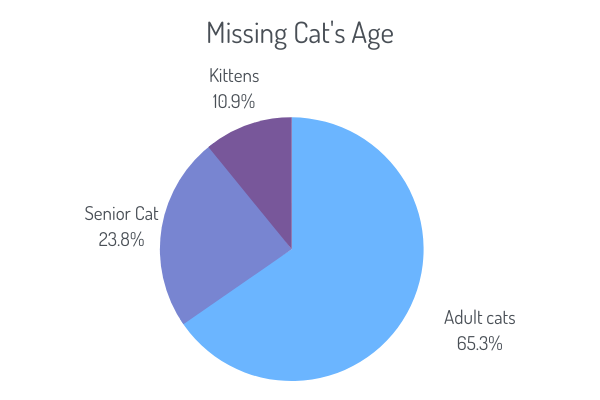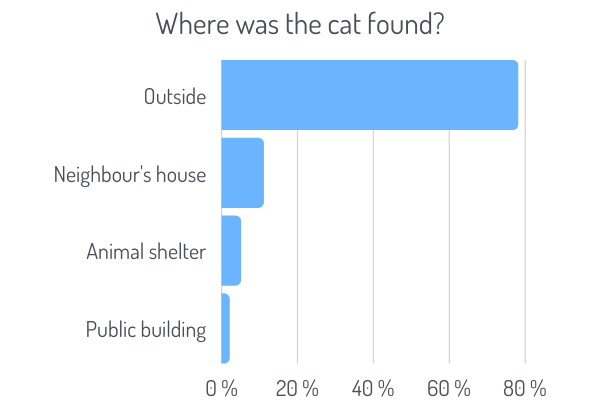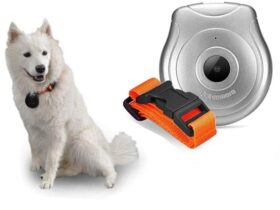Being a cat owner is not an easy job, and you need to keep an eye on her because in a second she can go missing outside. According to lost cat statistics, a high percentage of cats get lost at least once in their lifetime.
Many cat owners reported they didn’t put a collar with ID because the cat doesn’t like to wear it. But, do you know how many cats were successfully found because of information on the collar?
Cats have a great instinct and easily memorized their new home, using a sense of smell. Some of them can go far away and quickly come back home when they’re hungry. Do you know how far a cat can navigate the way to the house?
We prepared some of the most interesting cat lost statistics and facts which will for sure surprise you.
7 Lost Cat Statistics
(Editor’s pick)
- Over 10 million pets get lost every year in the United States.
- Only 25% of found cats were wearing any ID.
- More than 60% of missing pets are adult cats.
- Between 53-75% of missing cats are found.
- According to statistics, 15% of cat owners lost their pets in 5 years.
- Around 59% of cats returned home on their own.
- Cats can stay away from home for up to 10 days.
13 Most Interesting Lost Cat Statistics
1. Over 10 million pets get lost every year in the United States
According to American Humane Society data, over 10 million pets get lost every year. Most of them include dogs and cats, which are the most popular pets in the country.
The main reason why cats easily get lost is because of accidentally opened windows, front doors, and they can quickly jump on the street and get lost in the neighborhood. Luckily, a high percentage of them will come back home or be found in a short time.
Source: luckypet.com
2. Only 25% of found cats were wearing any ID
If the cat has some identification like a microchip, collar with contact, or address, it is a high possibility she will be returned to their owners in a short time. A study from 2012. report that around only 25% of cats that get lost had ID. Even if some cats have IDs, not all of them will be returned to their owners.
In some cases, owner information on file is not accurate, and only 58% of lost cats will find their owner. Less than 15% of cats have microchips that include all needed information about owners, like address and phone number. Around 27% of lost cats had a rabies tag and 21% of them had licenses.
The highest percentage of cats, around 56%, that are found or come back home on their own didna have any identification. The top reason why cats don’t have tags is the owners said they’re indoor cats or their cat doesn’t like to wear collars.
Even if there is a high percentage of cats without any identification that successfully come back home, it is always recommended to have the collar, even if they’re indoor cats.
Source: luckypet.com
3. One study revealed that around 40% of owners said their cat was inside while they were searching for her
Not all the missing cats are found in the neighborhood, or animal shelter, believe it or not, some cats were hiding inside the house. According to one study that included owners that we’re searching for cats, results show that 41% of them searched for a pet outside the house, while all the time cat was inside.
Cats are known to easily hide in the thinnest area and sleep a lot. They’re not loud when walking, comparing it to dogs, so it is possible that you will not notice a cat is somewhere in the house even if you’re calling her.
Source: luckypet.com
4. More than 60% of missing pets are adult cats
There is a much higher possibility that adult cats will go missing than kittens, mostly because they’re used to going explore around and love to hunt.
Surveys from different cities show that around 66 % of missing cats are adult ones. In second place are senior cats with 24% and only 10% of kittens will be lost.


Source: lostpetresearch.com
5. According to statistics, 15% of cat owners lost their pet in 5 years
If the cat owner doesn’t have an indoor pet, it is possible she will hang around the neighborhood while being left outside. Cats love to hunt, play and jump on different objects, and can easily get lost for a short time.
According to missing cat statistics about lost cats in the last five years, around 15 % of cat owners admitted their pets get lost at least once in this period.
Source: lostpetresearch.com
6. Studies show that from 12-18% of cats will be missing at least once in a life
There are millions of households with cats, and some of them have only indoor cats while the rest of them prefer leaving cats in the backyard.
Statistics show that from 12-18% of cats will go missing at least once during their lifetime. Even if this percentage is above 20, this is still a high number of missing pets, and not all of them found their way back home.
Source: lostpetresearch.com
7. Between 53-75% of missing cats are found
Every day there are thousands of missing cats nationwide, and owners are worried about where is the pet and if it will come back. Studies show that 53-75% of missing cats will successfully come back home in a short time.
Part of the lost cats ended up in animal shelters, but Animal Control in towns doesn’t usually pick up stray cats. If the cat is missing, usually she is somewhere nearby in the neighborhood.
Source: lostpetresearch.com
8. Around 75% of cats were found in a circle of 500 m
There is no neighborhood that doesn’t have cats, and they can easily move around, especially if they’re indoor/outdoor cats. Cats love to visit other cats, especially during the mating period.
Statistics show that most of the found cats, approximately 75%, were found within a 500m radius from the house. Physical search increased the chance owner will find their cat.
Source: ncbi.gov
9. According to stats, 59% of cats returned home on their own
Animals can easily find their way back home, as well as cats. They will follow the smell and easily come back home if they’re not going too far away.
According to statistics, around 59% of cats returned home on their own. About 30% of cat owners find their cat in the neighborhood and only 2% find their cat at local animal shelters.
Source: aspca.org
10. Statistics show that 78% of the lost cat was found outside
One of the surveys shows how most of the cats, around 78% of them were outside while owners were looking for them. 11% of lost cats were at a neighbor’s house usually somewhere where are other animals.
Around 5% of cats were found in animal shelters, mostly because someone picked them up from the street Only 2% of cats were found in public buildings nearby.


Source:lostpetresearch.com
11. Cats can stay away from home for up to 10 days
It is not usually for cats to go missing for more than 1 day, especially if they’re outdoor cats. But in some cases, cats can go missing for up to 10 days.
It is not unusual case cats will go missing while their owners are on vacation, and they will return bask home the moment they notice the returned. Cats will easily find a place for sleep and food to survive.
Source: aspca.org
12. Reports say that around 30% of cats tried to return home but didn’t know the right path
Even if all cats have homing instincts and easily memorize the magnetic map and where is their home, some of them don’t have those strong instincts and they’re not able to flow the trail back home.
No matter if the cat is indoor, outdoor, or stray, there are reports that say up to 30% of cats tried to return but didn’t know where to go. In some cases, this can happen if you change the address, and the cat may travel back to the old house, especially if they live for a long time there.
Source: petmd.com
13. According to research, domestic cats can navigate their way home to 4 miles away
Cats, just like other animals, have an extraordinary sense of smell which mostly is used to detect any predators nearby, but also to help them get back home. Most of the cats know how to get home if you let them outside, and the smell plays a big part in that.
One study shows that domestic cats can navigate to come back home even if they’re 1.5 to 4 miles away.
Source: petmd.com
To Sum Up
Lost cat statistics show there are thousands of cats missing every day. Fortunately, many statistics show how the highest percentage of lost cats was found. Most of them, around 80% was outside, mostly in the circle of 500 m. Cats, and especially outdoor cats, tend to hide somewhere but will find their way back home because of strong smell instinct. For easier finding it is recommended to buy a collar with identification like address or phone number, as well as a microchip pet even if it is an indoor cat.


































Leave a Reply